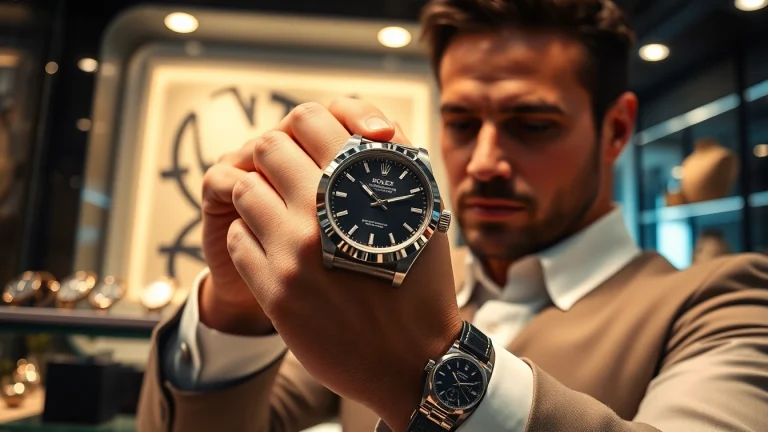
Sell Luxury Watch: Expert Tips and Insights for a Profitable Transaction
Understanding the Luxury Watch Market
Overview of Luxury Watch Brands
The luxury watch market represents an intersection of artistry, craftsmanship, and investment potential. Renowned brands like Rolex, Patek Philippe, Audemars Piguet, and Omega are not just watchmakers; they are symbols of prestige and exclusivity. Each name signifies a unique heritage, often steeped in decades or even centuries of history. For instance, Rolex, established in 1905, has become synonymous with success and has an extensive suite of models known for their reliability and precision.
On the other hand, Patek Philippe, crafted in 1839, is revered for its intricate complications and limited production, making its pieces some of the most sought-after in auctions. As of late, brands like Richard Mille and Hublot have also gained momentum, focusing on bold designs and innovative materials, appealing to a modern, affluent demographic eager for luxury with a twist.
Market Trends in Selling Luxury Watches
The landscape of the luxury watch market has evolved significantly over the past decade, primarily due to the digital transformation of buying and selling methods. Online platforms such as Chrono24 and Watchfinder have revolutionized how collectors and individuals can sell luxury watches, allowing for direct access to global buyers. This digital shift has made the process more accessible, transparent, and competitive.
Recent trends indicate a rising appreciation for vintage and pre-owned timepieces. Many enthusiasts value heritage and authenticity, leading to demand spikes in specific models. For instance, the vintage Rolex Daytona or the Patek Philippe Nautilus has witnessed skyrocketing prices at auction, often exceeding their original retail values. This surge has become notable for collectors and investors alike, making luxury watches a lucrative avenue.
Factors Affecting Watch Value
Several interconnected factors influence the value of luxury watches. Firstly, brand reputation plays a crucial role. Renowned brands with consistent quality tend to maintain higher resale values. Secondly, the condition of the watch is paramount; pristine examples often fetch higher prices than those that exhibit wear and tear.
Additional factors include rarity, model popularity, and market demand. For instance, limited editions or discontinued models can appreciate significantly, driven by collector desire. Additionally, the accompanying documentation (like box, papers, and service history) enhances appeal and value. Lastly, economic conditions also affect luxury markets, as discretionary spending fluctuates with consumer confidence and market stability.
How to Prepare Your Watch for Sale
Cleaning and Maintaining Your Watch
Before placing a luxury watch on the market, proper cleaning and maintenance are vital for presenting it in the best light. Start by gently cleaning the case and bracelet using a microfiber cloth tailored for delicate surfaces. For more intricate dirt, a mild soap solution with water can be used; however, avoid soaking the watch unless water-resistant.
It’s wise to avoid abrasive chemicals or scrubbing tools that might damage the finish or components of the watch. If feasible, consider having the watch professionally serviced to ensure it’s operating correctly. A verified service record may serve as a significant selling point, reassuring potential buyers of its mechanical integrity.
Gathering Documentation and Appraisal
Documentation significantly enhances the selling process, providing evidence of authenticity and ownership history. This includes the watch’s original box, warranty papers, and service history. If you can obtain an appraisal from a certified watchmaker, it could also facilitate a quicker sale at a desirable price point. Appraisals typically consider brand, model, condition, and historical significance, establishing a fair market value.
Having a formal appraisal can also elevate the buyer’s trust, especially for high-value transactions. Additionally, take high-quality photographs from multiple angles while showcasing any unique features or imperfections – this visual documentation is essential for online listings.
Choosing the Right Sales Method
Deciding on a sales method influences how quickly and profitably you can sell your watch. Traditional retailers might offer immediate cash or store credit but may not provide the highest possible price due to their markup on good resale value. As an alternative, online platforms allow for direct sales to consumers, offering competitive prices due to lower overhead costs.
Consider platforms like Chrono24 or eBay that provide robust systems for auction-style selling, giving you the leverage to set a starting price. Moreover, dealers who specialize in luxury watches can provide instant offers but may present lower valuations to account for their resale risk. Each method has pros and cons; thus, evaluating what works best for your situation is essential.
Where to Sell Your Luxury Watch
Online Platforms: Pros and Cons
Online platforms have become increasingly popular for selling luxury watches, offering a broad reach and potential buyers worldwide. Websites like Chrono24 and Watchfinder provide user-friendly interfaces, allowing sellers to list their items quickly. These platforms often have a dedicated audience of watch enthusiasts, increasing the likelihood of a successful sale.
That said, using these platforms comes with certain downsides. For example, commission fees can reduce your overall earnings, and you may have to wait for a relevant buyer. Moreover, the seller is responsible for ensuring secure transaction terms, which might be daunting for first-time sellers.
Local Jewelers vs. Online Auctions
Local jewelers often provide a more personal selling experience, allowing for in-person appraisals and immediate cash offers. They can also assist with the selling process, alleviating some burdens from the seller. However, jewelers may offer lower prices than what you could achieve through online auctions due to their need to resell at a profit.
Conversely, online auctions can result in higher selling prices but come with associated fees and a more significant time commitment, as you must manage bids and communicate across a digital platform.
Maximizing Offers from Buyers
Whether selling to a dealer or through an online platform, you can maximize your offers with strategic planning. Research similar models to understand current market value, making it easier to justify your asking price. Be transparent about the watch’s condition and any notable features or provenance it boasts, negotiating effectively with potential buyers. Additionally, savvy presentations backed by quality images and documentation can improve buyer confidence and willingness to pay top dollar.
Best Practices for Successful Transactions
Negotiating with Potential Buyers
Negotiation is an art, and understanding the buyer’s perspective is key. Start by establishing a fair price based on research and be prepared for counteroffers. Active listening helps gauge buyer interest and readiness to close the deal. Flexibility in negotiations can build rapport and lead to a smoother transaction, but ensure you maintain a clear boundary regarding your lowest acceptable price.
Ensuring Secure Payment Methods
In today’s digital marketplace, ensuring secure payment methods is paramount to avoid scams and protect your financial information. Platforms like PayPal and bank transfers are preferred due to their traceability and buyer protections. If selling locally, cash transactions provide instant gratification, but ensure you meet in a public, secure location. Keeping clear documentation of payments and agreements further solidifies the transaction’s integrity.
Understanding Shipping and Consignment Agreements
If the sale involves shipping, ensure that the watch is packaged securely to avoid damage during transit. Shipping insurance is a worthwhile investment to protect both buyer and seller interests. If you’re opting for a consignment, read through the agreement carefully, noting fees, timelines, and the processes for dispute resolution.
Post-Sale Considerations
Tax Implications of Selling Luxury Watches
When a luxury watch sells, sellers must consider the tax implications of their transaction. In many jurisdictions, profit from the sale of personal items can be subject to capital gains tax, especially if the watch appreciates over time. It’s advisable to consult with a tax professional to understand liabilities associated in your region or any documentation you need to retain for tax reporting purposes.
Customer Feedback and Testimonials
After the sale, gathering feedback can bolster your credibility for future transactions. Encouraging buyers to leave reviews can enhance your profile if selling through online platforms. Positive testimonials not only aid in future negotiations but also build a trusted reputation within the luxury watch community.
Tracking the Market After Your Sale
Monitoring market trends post-sale allows you to stay current with pricing and demand developments. Understanding how values are fluctuating can help you make informed decisions for future purchases or sales. Platforms like WatchCharts can help you track price movements and understand the current market sentiment. Engaging with communities on social media can also provide insights and early indications of emerging trends.


